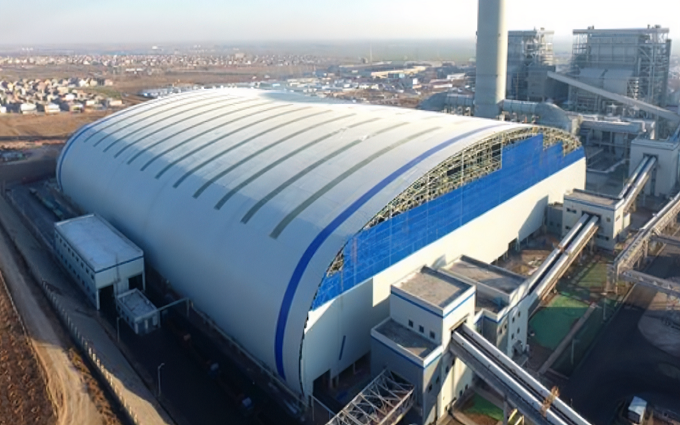Advantages of Using Steel Structures for Coal Storage Sheds

Coal storage sheds are evolving, with steel membrane structures gaining widespread attention in the industry. How do these steel membrane structures compare to traditional coal sheds? This comprehensive analysis explores the significant advantages of steel membrane coal storage sheds.
Advantages in Construction
Traditional coal sheds face numerous challenges during construction, including high-altitude work, large workloads, and multiple safety hazards. In contrast, steel membrane coal sheds offer notable construction advantages. The high-altitude work level is reduced to grade two, and the workload is significantly lower. For the same area, the high-altitude and hoisting workload of steel membrane coal sheds is considerably reduced, enhancing construction safety and efficiency.
Fire Resistance of Materials
Traditional coal sheds typically use single-layer color steel tiles, which are non-combustible but have limited fire resistance, usually between 0.5 and 2 hours. These tiles conduct heat quickly, potentially igniting other combustible materials. Although fire safety codes require at least one hour of fire resistance and the application of fireproof coatings, these measures are often ineffective in coal storage environments. Frequent water sprays for dust suppression and high humidity cause fireproof coatings to peel off, while the uneven surface of the coatings easily attracts coal dust, which ignites more readily than coal in a fire. Additionally, molten drips from the steel tiles can ignite other materials, blocking escape routes.
In contrast, steel membrane coal sheds use membrane materials with excellent fire resistance, classified as B1 grade (hardly flammable). These materials self-extinguish when removed from the fire source, preventing the spread of flames. The membrane material forms holes when melted, allowing smoke to escape and facilitating evacuation. Moreover, the Steel structure of these sheds can be equipped with fire protection measures to enhance overall fire resistance.
Wind and Snow Load Resistance
Traditional coal sheds may become unstable or damaged under extreme weather conditions like strong winds or heavy snow. Single-layer steel tiles have limited capacity to withstand wind and snow loads, which can lead to structural damage or collapse. Maintenance costs are also high, requiring regular inspections and repairs to counteract natural wear and tear.
Steel membrane coal sheds, however, exhibit significant advantages in wind and snow load resistance. Their unique design, combining membrane structures with high-strength steel, ensures structural stability even under extreme weather conditions. The membrane material’s elasticity and self-recovery capabilities effectively counteract wind and snow impacts. Additionally, these sheds are waterproof, corrosion-resistant, and durable, significantly reducing maintenance costs and extending their lifespan.
Conclusion
Steel membrane coal storage sheds demonstrate clear advantages in construction, material fire resistance, and resistance to wind and snow loads. With continuous technological advancements and increasing environmental requirements, steel membrane coal sheds are poised to become the mainstream trend in coal storage construction. However, ongoing improvements and optimizations are necessary to meet the evolving market demands and environmental standards.
RELATED NEWS
- Understanding Primary and Secondary Members in Steel Structures 2024-07-05
- Is a Steel Villa Easily Destroyed? Let's Find Out 2024-06-12
- Do You Know the Differences Between Tube Trusses, Trusses, and space frame Stru 2024-05-30
- The Ultimate Guide to Choosing the Right Gas Station Canopy 2024-05-27
- Illustration of the difference between truss and space frame 2024-05-06
Categories
Latest News
Contact Us
Contact: Mr.Lu
Phone: +86-51668601029
E-mail: hbktech@163.com
Whatsapp:86+15152106218
Add: 1412, Building 2, Vanke Huaihai Xintiandi, Block 3, Quanshan District, Xuzhou City, Jiangsu Province
